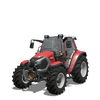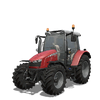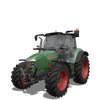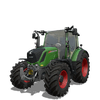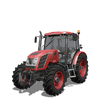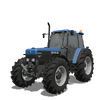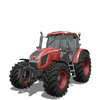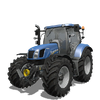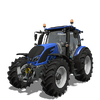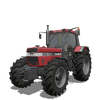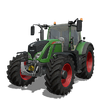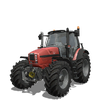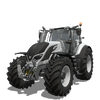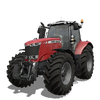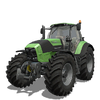Front Loaders/Farming Simulator 17
A Front Loader is a Tractor that has been specially modified to work as a Loader. It must be upgraded at the store or at a Workshop, adding a special attachment point. A Front-Loading Arm must then be fitted to that attachment point. Finally, Loading Tools can then be attached to the arm in order to perform a variety of Loading Work.
Only some Tractor models - specifically Small and Medium tractors - can be fitted with the special upgrade. Some models of Small and Medium tractors lack this upgrade altogether. The upgrade is cheap and affordable. In addition, a Front Loading Arm must be bought at the store, as well as an appropriate tool for the task at hand. Together with the price of the Tractor itself, this makes Front Loaders some of the more expensive Loaders available in the game.
The primary advantage of Front Loaders is their versatility. They have access to a wide variety of tools for many different kinds of Loading Work. Furthermore, when the loading work is done, the Front Loader is still a tractor; It can go right back to working your fields and towing your machinery. In the long run, a Front Loader can be very economically viable. On the other hand, Front Loaders are not the best Loaders for any job - they are "jacks of all trades", masters of none.
In Farming Simulator 17, there are 19 models of Tractors that can become Front Loaders. The description for each of these models at the store, as well as their articles on this Wiki, clearly state which tractors can be fitted with a Front Loading Arm attachment. All other tractor models cannot become Front Loaders.
Additionally, the base game features a Front Loader/Telehandler hybrid, which combines different features from each of the two Loader families.
List of Front-Loading Tractors
Below is a list of all 19 models of Tractors in Farming Simulator 17 that can be upgraded with a "Front Loader Attacher" to become Front Loaders. All other models cannot receive the upgrade.
| Name | Price | Maintenance cost per day |
Horsepower | Max Speed (km/h) |
Fuel Capacity |
|---|---|---|---|---|---|
| Steyr Multi | 82,000 | 115 | 99 | 40 | 150 |
| New Holland T5 | 83,000 | 110 | 99 | 40 | 165 |
| Lindner Lintrac 90 | 84,000 | 115 | 102 | 40 | 80 |
| Massey Ferguson MF 5600 | 87,000 | 120 | 105 | 40 | 160 |
| Hürlimann XM T4i | 91,000 | 130 | 110 | 40 | 160 |
| Fendt 300 Vario | 111,000 | 100 | 110 | 40 | 210 |
| Zetor Proxima Power 120 | 89,000 | 170 | 117 | 40 | 180 |
| New Holland 8340 | 85,000 | 200 | 125 | 40 | 218 |
| Zetor Forterra HD | 99,000 | 180 | 127 | 40 | 220 |
| New Holland T6 | 117,000 | 170 | 143 | 50 | 175 |
| Valtra N Series | 119,000 | 170 | 145 | 50 | 315 |
| Case IH 1455 XL | 102,000 | 260 | 145 | 40 | 240 |
| Fendt 700 Vario | 164,000 | 160 | 165 | 50 | 400 |
| Same Fortis | 138,000 | 190 | 166 | 50 | 280 |
| Valtra T Series | 170,000 | 260 | 210 | 50 | 380 |
| Massey Ferguson MF 7700 | 172,000 | 250 | 210 | 50 | 430 |
| Deutz Fahr Series 7 | 185,000 | 270 | 224 | 60 | 435 |
| Lamborghini Mach VRT | 189,000 | 270 | 224 | 60 | 400 |
| Case IH Puma CVX | 192,000 | 190 | 225 | 50 | 330 |
An additional unique hybrid model can be found in the "Front Loaders" section of the store. While technically similar to a Telehandler, it can only be fitted with Tools designed for Front Loaders (also found in that section of the store). It does not require an upgrade or Front Loading Arm to use those tools.
| Name | Price | Maintenance cost per day |
Horsepower | Max Speed (km/h) |
Fuel Capacity |
|---|---|---|---|---|---|
| Kramer KL30.8T | 60,000 | 130 | 75 | 40 | 85 |
Choosing a Tractor
Choosing which Tractor to turn into a Front Loader is complicated. There are 19 different models of Tractors available, and it's not always just a matter of "stronger is better".
There are many factors that can affect a tractor's performance when used as a loader. This includes the tractor's weight, whether it has any tire modifications, and even its maximum reverse speed. Engine power is also important, of course - but only in relation to the tractor's weight.
There are also financial concerns, as with any tool. Front Loaders are the cheapest of all Loaders - as long as you modify a Tractor that you already own. When buying a brand new tractor to serve as front loader, the costs go up sharply.
Acceleration from a Standstill
Loading Work typically involves alot of backwards and forwards movement, over very short distances. The ability of a tractor to quickly accelerate from a complete standstill to a reasonable speed is therefore very important to any Loader. When choosing a Tractor model for Front-Loading duties, it is important to examine the tractor's Horsepower-to-Weight ratio, rather than looking at Horsepower alone.
A few models, like the Case IH Puma CVX, have a very high HP/Weight ratio, and are excellent for this job. A much cheaper and smaller model is the Lindner Lintrac 90. Conversely, tractors like the Hürlimann XM T4i are very heavy for their engines, and do not accelerate very quickly - ultimately making the Front-Loading work harder.
Note that Maximum Speed can be totally irrelevant for Front Loaders, if they are expected to work only in one given area, such as Animal Husbandry tractors. Unless a Front Loader is expected to need to haul cargo from place to place, it does not need to be very fast.
Maneuverability, Precision, and Size
Loading work often requires precision - whether for carefully picking up cargo or for putting it down in the right place. A tractor with a small turning radius usually has the advantage here, and this typically results from smaller wheels whose axles are closer together; In other words, smaller tractors. Furthermore, smaller tractors - being shorter and narrower - have less trouble navigating in tight spaces, such as those found around storage areas or Animal Pens.
This makes smaller tractors more suitable for those Loading jobs that involve precision, e.g. loading Pallets or Bales onto a trailer, or stacking these objects.
Conversely, if the job at hand involves little precision (e.g. shoveling Piles into Containers), smaller tractors are less suitable due to their Weight Stability issues (see next subsection).
Weight Stability
The weight of the tractor is an important factor in-and-of-itself, because a heavier tractor has more innate stability than a lighter one - its weight counter-balances the weight of the Front-Loading Tool and the cargo it is lifting.
It is of course possible to increase the balance of a smaller tractor by adding a Weight at the back. However, this not only costs extra, but also makes the tractor heavier relative to its Horsepower (see prev. subsection), reducing acceleration. An innately-heavy tractor with a suitably powerful engine is generally a better choice - assuming you can afford one.
Several of the Front Loading Tractor models can be fitted with Wheel Weights, which are generally a good choice. These will counter-balance the lifted cargo quite effectively, keeping the rear wheels more firmly planted on the ground.
Max. Reverse Speed
Loading Work, unlike fieldwork, frequently involves driving in reverse. Most tractors have a very low Maximum Speed when traveling in reverse, compared to their maximum forward speed.
Nonetheless, a few tractor models, particularly those manufactured by Valtra, have a respectable maximum reverse speed. This can come in handy during any Front-Loading work, but especially in any job that requires constant forward-and-backward movement, e.g. shoveling or leveling.
Price
Finally, as with any other machine, it is important to look at pricing concerns.
Front Loaders are typically the cheapest of all Loaders, but do not really excel at any specific loading job. Therefore, they are typically used when you do not yet have have the cash to buy a dedicated Loader for the job at hand. Unless you're buying a brand new Tractor to be your Front Loader, the equipment is remarkably cheap - as little as $6000-$7000 - and you're likely to already have at least one Front-Loading-Ready tractor at the start of the game to install it on.
On the other hand, if you're going to buy a new tractor specifically for Front Loading work, the costs skyrocket. A new tractor costs at least $82,000, and the largest and heaviest Front-Loaders cost almost $200,000. Therefore, it is not advisable to buy a completely new Front Loader instead of a Skid Steer Loader, Telehandler or Wheel Loader, unless you know that you specifically need a Front Loader for the kind of work at hand.
For example, Front Loaders are generally very good at Animal Husbandry, thanks to their ability to tow and power other machines. When looking for a permanent machine to tend to your animals, a Front Loader is a good choice, and you should spend the money to buy a good one. If you're looking for a permanent machine to handle your shoveling, for example, it's a good idea to buy a Wheel Loader instead - and for much less money.
Upgrading to a Front Loader
In order for a Tractor to become a Front Loader, it must first be fitted with a special upgrade called a "Front Loader Attacher". This upgrade is only available to the tractor models listed above.
The Front Loader Attacher upgrade can be installed during purchase. If you've already bought a valid Tractor, you can take it to the store's sale point and upgrade it there, or bring it to your Workshop (if you have one) to install the upgrade. The upgrade can also be removed at any time, using the same method.
The Front Loader Attacher upgrade costs exactly $800, regardless of what model of tractor you install it on. This makes Front Loaders very affordable in the early game, as you probably already own at least one tractor that could be refitted with this upgrade, and the expense is very small.
Once installed, the tractor's in-game model will change slightly, and will now feature two new attachment points at the front of the tractor on either side of the engine hood. This is where a Front Loading Arm can be attached to the tractor.
Note that the Front Loader Attacher upgrade adds these attachment points - it does not remove the existing Three-point hitch on the front of your tractor. However, as long as a Front Loading Arm is attached, it is difficult to also attach an implement to the front of the tractor.
Attaching a Loading Arm and Tool
- Main article: Front Loading Arms (Farming Simulator 17)
Once you've modified your Tractor for Front-Loading, you need to buy at least two additional pieces of equipment: A Front Loading Arm and a Loading Tool with the correct attachment point. These can be found in the "Front Loaders" category at the store.
There are two models of Front Loading Arms in the base game, and they are very similar to one another. Other than a price difference, the more expensive model is slightly longer than the shorter model - giving a slightly higher reach. Whichever arm you purchase, it can be attached directly to the attachment point you've installed on your tractor (see prev. section), whenever you need to do Front Loading Work.
After installing the arm, a Loading Tool can be attached at the end of that arm. Front Loaders have a very wide variety of tools available, and can technically perform any Loading Work with some degree of effectiveness. Front Loader Tools are generally small but cheap - they do not excel in any job.
A Tractor can still perform fieldwork (e.g. Fertilizing, Sowing) and tow trailers while it has the arm and tool attached. However, remember that both the arm and tool increase the tractor's weight. It's often better to detach them from the tractor temporarily whenever it isn't doing any Loading Work.
Comparison with Other Loaders
Front Loaders are one of four different types of Loaders. Below is a list of advantages and disadvantages of Front Loaders over the other three categories.
Advantages
- Jack of All Trades: Front Loaders do not really excel at any specific type of lifting - but they are generally capable of performing any lifting job adequately. Therefore, a single Front Loader can handle the bulk of your lifting until other, dedicated Loaders (a Skid Steer Loader, Wheel Loader or Telehandler) can be purchased for specific jobs.
- Good Tool Variety: Front Loaders have access to almost all different types of Loading Tools. With these tools, they can perform nearly any kind of lifting job.
- Cheap: As long as you're converting a Tractor that you already own into a Front Loader, the costs involved are much smaller than purchasing a brand new dedicated Loader of any type. This makes a Front Loader a good temporary "stand-in" until you can afford a dedicated Loader.
- Is a Tractor: It's important to remember that a Front Loader never stops being a Tractor for all intents and purposes. It can effectively tow and use Implements and Containers, and can do fieldwork whenever it doesn't need to do any lifting. In particular, this makes Front Loaders excellent for Animal Husbandry, a job that requires lifting as well as towing and operating other machines. A single Front Loader can handle all the work around an Animal Pen on its own.
Disadvantages
- Best at None: Front Loaders are not the best for any specific Loading Jobs. They don't have the maneuverability or precision of a Skid Steer Loader; They don't have the reach of a Telehandler; And they don't have access to the massive tools used by a Wheel Loader. For any job that requires such properties, a dedicated Loader is better than a Front Loader.



